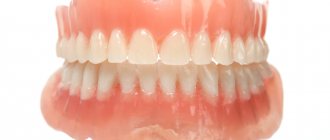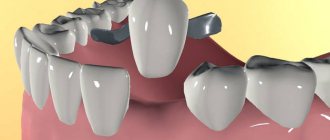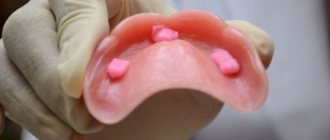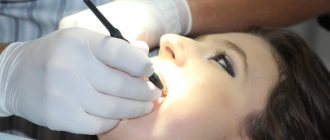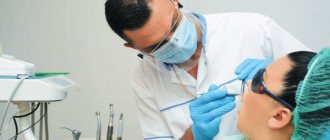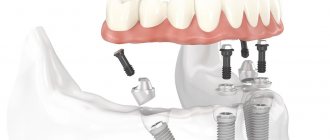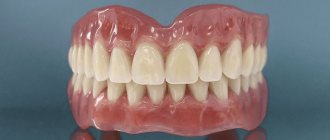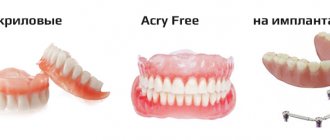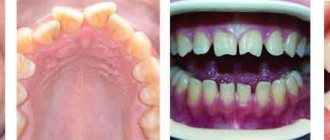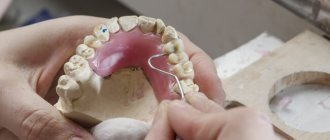- Complete removable dentures in Moscow
- Indications for use
- Types of removable dentures in complete absence of teeth
- Plate dentures for the entire jaw
- Removable dentures made of soft plastic
- Acrylic dentures for all teeth
- Removable nylon dentures
- Complete removable silicone dentures
- Clasp dentures for the entire jaw
- Pros and cons of complete dentures
- Preparation for prosthetics
- Manufacturing of complete removable dentures
- Fixation
- Care of complete dentures
- Complete removable dentures price
If we look at official statistics, almost half of the residents of our country by the age of 65 are faced with the problem of complete loss of teeth. In medical practice, this phenomenon is called adentia. This situation should not be ignored, since edentia is not just an aesthetic defect that can cause psychological discomfort in the patient and affect self-esteem. Losing teeth is dangerous because it triggers a series of more serious health problems: the process of grinding food worsens, which leads to dysfunction of the digestive organs, impairs intestinal function, and as a result, the functioning of all internal organs is disrupted.
The most progressive methods of restoring lost teeth are prosthetics on implants or the use of removable structures. Despite all the visible advantages of implantation, this method also has significant disadvantages. It may not be suitable for patients because it requires surgery, which may be contraindicated. And the second significant point is the high cost of all manipulations. An alternative, universal and suitable method of prosthetics for completely edentulous patients is the production and installation of removable orthopedic dental structures.
Removable dentures are distinguished by the fact that they can be removed and put on independently, at any time, without the involvement of specialists. There are two types of these structures:
- partially removable dentures;
- complete removable dentures.
Indications for use
As a rule, complete removable dentures are indicated for defects in a number of teeth, such as complete loss of chewing teeth. In addition, the pathological condition of the periodontium may be an indication. Severe periodontitis requires the installation of such structures; this will be the best solution for patients with this disease. The choice of the type of prosthesis depends on the specific case; the decision is made by the doctor together with the patient, based on a thorough examination of the oral cavity.
Are there any disadvantages to silicone-based prostheses?
If we focus on patient reviews about soft dentures, then the main disadvantage is their higher price, while dentists recommend paying attention to some other points:
- The elasticity of the base does not allow effective replacement of the entire dentition. With prolonged use, bone tissue atrophy is possible.
- Frequent replacement of the silicone gasket of the prosthesis due to the fact that it wears out faster.
- The need for frequent ultrasonic cleaning of the base, since its porous surface is quickly covered with plaque.
- The short service life of the prosthesis is no more than 5 years. In some cases, it may even decrease to 2-3 years.
- The need for careful home hygiene of the structure.
How to care for silicone dentures?
When making a prosthesis with a soft lining, a special material is used - silicone, which is extremely quickly subject to microbial contamination. To prevent this from happening, the following measures must be taken:
- After removing the structure from the mouth, it must be placed in a container with water or disinfectant. The soft base should not dry out. For hygiene measures, always use water at room temperature.
- The denture must be cleaned regularly with a special soft brush and a small amount of toothpaste.
- Oral hygiene should not be neglected. Regularly clean any remaining plaque from your teeth, gums, and tongue.
Dental prosthetics is a field of dentistry that is rapidly developing. Science is offering patients more and more ways to effectively replace lost teeth with aesthetic results and high daily comfort. For example, dentures are made from a large number of materials that vary in properties and prices. In this section, we want to take a closer look at the so-called silicone dentures, which got their name thanks to the patients themselves. By and large, it is not entirely accurate. These removable structures began to be called silicone because of their flexibility and elasticity, which have associations with the material of the same name. In fact, these types of dentures are made from acrylic, nylon or polyurethane. We invite you to take a closer look at their properties, indications for use and advantages.
Types of removable dentures in complete absence of teeth
If there are no teeth left, the choice of design is significantly limited. Modern medicine offers the installation of prostheses on implants - this is the most reliable and most aesthetic method, but it is not available to everyone due to its high cost and indications. In this case, plate dentures remain - they are suitable for people of any age, if there are no allergic manifestations to the material used to create them. In the absence of teeth, all structures are similar in structure, but can be made of different materials. Let's decide what the pros and cons of different options are.
Plate dentures
Plate dentures, as the name implies, are a plate of different sizes. It acts as the basis of the structure, its basis. Fixing elements and artificial teeth are attached to it. Previously, such dentures were made exclusively from hard materials, but today dental technicians have a wider choice. This allows you to select products individually for patients, based on their needs and financial capabilities. But here it is necessary to remember that the material affects not only the comfort of wearing a denture, but also its service life.
Soft plastic dentures
Thus, acrylic products are considered the most durable. But since they are not always comfortable to wear, the formula of the material has been refined and improved. Complete removable dentures made of soft plastic were born. They are a combination of acrylic with the addition of additional components (for example, diamond chips). Their service life is very impressive, but due to their more plastic structure, they do not injure the gums, do not rub, and provide a tight fit.
Acrylic dentures
This type of prosthesis is the most popular - it is characterized by low price, aesthetics and ease of use. It consists of a base that covers the alveolar process and the body of the jaw, and artificial teeth attached to it. Before installing such a prosthesis, as in other cases, the oral cavity is first prepared for prosthetics, loose teeth are removed and the mucous membrane is treated, and then an impression of the jaws is made. Based on the impression, a primary model is created in the laboratory, which is adjusted and corrected after fitting. Acrylic or plastic prosthesis has the following advantages:
- an affordable way to completely restore teeth;
- ease of use;
- durability (7-9 years with proper care);
- uniform distribution of chewing load;
- quick adaptation period;
- lightness of the material, comfort of use;
- aesthetics and the ability to create a prosthesis that perfectly matches the color of natural gums;
- possibility of repair and correction;
- quick installation.
However, in order to decide which prosthesis is best to choose, you should know not only the advantages, but also the disadvantages of each type of design. For acrylic dentures, this is the possibility of an allergic reaction to the material, trauma to soft tissues during use, bad breath (acrylic is a porous material, bacteria can multiply in it), partial loss of taste, increased gag reflex, temporary impairment of diction and frequent need for correction. Most of these negative effects go away as you get used to the prosthesis, but some you have to put up with. To complete the adaptation period as quickly as possible, do not remove the denture at night.
Nylon dentures
The products are made from pink nylon, which is elastic and durable. They are similar to plate acrylic dentures, but differ from them in some parameters. This design perfectly imitates the gum and part of the alveolar process, it holds well and is suitable for sports enthusiasts. Such dentures are not removed at night even after the end of the adjustment period. A nylon prosthesis has the following advantages:
- hypoallergenic;
- high aesthetics;
- reliable fixation;
- low porosity, and, as a result, the absence of bad breath even after long-term use;
- flexibility, elasticity, comfortable use;
- durability (about 5 years);
- rare percentage of breakdowns.
The disadvantages of this type include the need for care of the prosthesis with the help of special means, the inability to repair in case of breakage, possible bone atrophy and mucosal injuries with prolonged use, uneven distribution of the chewing load (the flexible frame prevents this), the need for frequent correction and relatively high price.
In case of complete absence of teeth, implants are used to better fix the structure, and a metal arch is often used, which enhances the strength of the base. Thus, nyl dentures resemble dentures with a metal base and become even more durable.
Silicone prostheses
They are similar to nylon, but very different from them. Silicone is translucent; artificial – most often plastic – teeth are attached to a base made of it. Silicone dentures, as a rule, are used as temporary ones, because large gaps form between the teeth over time, and the service life of the structure is no more than two years, and it is rarely used for complete dentures. Their advantages:
- natural appearance;
- no allergic reaction;
- lightness and compactness;
- good fixation;
- softness of the material.
With prolonged use of the structure, atrophy of the alveolar bone and subsidence of the gums are possible, which is its significant drawback. In addition, they provide poor distribution of the chewing load and are difficult to maintain.
Clasp dentures
Clasp-type structures are practically not used in cases of complete edentia, since for strong fixation it will be necessary to create supporting surfaces. This requires additional time and financial expenses.
Differences between fixation on the upper and lower jaw
Partial dentures are fixed to the gums using a base, as well as to supporting teeth using hooks. The device looks like a plastic arch with artificial crowns. The main difference is in the design of the palatal bridge.
The dentures for the top row are equipped with an artificial plastic palate (solid plate). The element increases the area of contact surfaces, thereby improving fixation. The devices are bulky, making it more difficult for patients to get used to them. But in the new generation of prostheses, this element is made in the form of a ring or arc, which makes the design easier.
On the lower jaw the bridge is narrow due to the frenulum of the tongue. The contact area is small, but this reduces the quality of fixation.
Pros and cons of complete dentures
Such designs are very popular; they have many advantages, including:
- Strength and elasticity . Prostheses are comfortable to wear, suitable for patients of all ages and safe. They are made according to an individual impression.
- High aesthetics . It is possible to choose the shape and color of teeth and gums as close as possible to natural ones. All this is selected on an individual basis.
- Easy to care for . Such structures are easy to care for; sometimes you just need to rinse them in running water.
The disadvantages include the following features:
- relatively long adaptation period;
- insufficiently stable fastening;
- feeling of discomfort when laughing, coughing or eating;
- not very long service life;
- food restrictions;
- violation of speech functions;
- the need for preventive regular examinations by a doctor.
For what purposes is a “butterfly” installed?
Many people believe that the main function of a “cosmetic bag” is aesthetic. It replaces an extracted tooth, restoring a beautiful smile. However, this is far from the only problem that an immediate prosthesis can solve. Tooth loss entails many other problems:
- Neighboring teeth suffer. Having lost their support, they begin to lean to the side, trying to fill the empty space (Popov-Godon phenomenon).
- It becomes more difficult to chew food, especially hard foods. This can cause problems in the gastrointestinal tract.
- Facial asymmetry develops.
- Diction is impaired and speech becomes less clear.
- The risk of developing caries and abrasion of enamel increases, since the load on the jaw is distributed unevenly.
- Bone tissue atrophies.
Installing a temporary prosthesis can prevent all of these problems from occurring.
Preparation for prosthetics
An important role in the manufacture of high-quality, comfortable designs is played by preparing the patient for prosthetics. The doctor conducts a detailed examination of the oral cavity, identifies individual structural features of the maxillofacial apparatus, and determines the characteristic features of the jaws. At this stage, the material for creating the future structure, the optimal shape, size and color of artificial teeth are selected.
Individual spoons are used. The composition of the mass for impressions is also selected personally. Based on the casts, a model of the jaws is made.
The finished product is made from wax or plaster models. This is quite painstaking work and is carried out using special equipment. In this case, it is important to clearly maintain the distance between the teeth, the depth of their fixation, inclination and many other parameters.
When trying on dentures, the dentist identifies possible nuances that prevent a tight fit. All comments are sent to the laboratory, where a dental technician adjusts the design.
Indications and contraindications for the installation of a cosmetic prosthesis
It’s worth mentioning right away that the “cosmetic bag” is not intended for long-term wear. It is used for a short period of time, usually before the installation of a permanent prosthesis or implant. "Butterfly" is irreplaceable:
- During the recovery period after tooth extraction, it is not yet possible to install a permanent prosthesis.
- At the stage of rehabilitation after surgery for implantation of dental implants.
- During the retention period after completion of orthodontic treatment.
- During the period of restoration of bone tissue, which has become thinner due to the prolonged absence of a tooth.
- In childhood and adolescence. Until the formation of the dental system is completed, the installation of permanent orthopedic structures does not make sense. They will still move and will need to be replaced.
A “cosmetic bag” can be installed for a patient for a longer period if for some reason he does not want to resort to permanent prosthetics using bridges or dental implants.
Despite the fact that installing a cosmetic prosthesis is a simple procedure that does not involve surgical intervention, there are a number of contraindications. These include:
- deformation, congenital or acquired, of the jaw;
- inflammatory process in the oral cavity;
- increased mobility, damage to neighboring teeth, which should serve as support for the prosthesis;
- abnormal jaw structure.
Manufacturing of complete removable dentures
The manufacturing process of both acrylic and nylon removable dentures occurs in several stages: taking impressions of the gums, casting a plate, welding teeth to it, and fitting the dentures to the patient’s jaws.
Acrylic dentures are produced by injection molding, and nylon ones are produced by hot injection under pressure. The latter method requires expensive modern equipment and qualified specialists who can work with such equipment. This has an impact on cost, and therefore nylon dentures are much more expensive than acrylic ones.
Reviews of silicone dental prostheses made at DentaGuard dentistry
You can read reviews about removable silicone dentures and their prices at the DentaGuard clinic in the relevant sections of the website.
I have been receiving treatment at the DentaGuard clinic from the wonderful doctor Elena Vasilievna Medvedeva since 2012. Recommended by a neighbor as a very good, professional doctor and an easy-going, wonderful person. Everything was bad and neglected for me. Elena Vasilievna took it upon herself and created a “system”.
All recommendations are absolutely accurate, enormous patience. Since then, the “system” has stood like its own. I forgot what dental problems are. And, most importantly, I know that Elena Vasilievna will accept and cope with any problem, jokingly, with her charming smile!
Thank you very much, Elena Vasilievna and the entire DentaGuard team. Vasilyeva Elena Nikolaevna
Care and storage
Dentures must be periodically removed from the mouth and cleaned. It's great if you do this every time after eating, but if this is not possible, you can rinse them in the morning and evening. Full dentures can be left in your mouth overnight, but it is best to remove them to give your gums a rest. In this case, before putting it in a special box, you need to thoroughly clean the prosthesis - rinse with boiled water, treat with an antiseptic solution or brush. It is recommended to have it professionally cleaned twice a year.
There is an opinion that the prosthesis should be stored in water or in a special solution. This is not so - a similar method was suitable for rubber prostheses, but modern technologies have made it possible to move away from it. Now it is enough to wrap the prosthesis in a cotton cloth and put it in a special box, where it will be protected from the sun, mechanical damage, heat and chemical influences.
Removable dental prosthetics: what is it?
Removable dentures are often the only way to restore the chewing function of the jaws and make the patient’s smile aesthetic.
If the situation allows, the orthopedic dentist suggests that the patient use fixed structures to restore the dentition: bridges, crowns, or prosthetics on implants.
However, it often happens that time is lost, the teeth cannot be returned , implants cannot be installed for some reason, or the patient himself does not have such a desire. In this case, the doctor will most likely suggest removable prosthetics.
As it becomes clear from the definition, the prosthesis can be removed. In cases with removable dentures, this can be done by the patient himself; in case of conditionally removable dentures, this procedure is carried out by a dentist.
In the vast majority of cases, the need to remove the denture arises only during hygiene measures (cleaning teeth and dentures). The rest of the time, both day and night, the patient wears it without taking it off.
Cost of complete removable dentures
| Name | Price from |
| Consultation with a specialist (included in the manufacturing cost when ordering a prosthesis) | 500 rub. |
| Cost of complete removable dentures for both jaws | 60,000 rub. |
The cost of services is determined individually for each patient, since the individual characteristics of the patient’s oral cavity play a key role in the manufacture of structures. Factors such as the anatomical structure of the maxillofacial apparatus, the chosen type of structure, the material of its manufacture and methods of fixation, the shape and color of artificial teeth are taken into account.
Denta Labor dental laboratory produces complete removable dentures of excellent quality. Our laboratory has created all the conditions to produce high-quality prostheses with a long service life. You can check prices for removable dentures by phone +7 (495) 162-08-25.
Promotion! When paying in advance the full cost of making the prosthesis, the cost is reduced by 2000.
Clasp dentures - a modern type of removable dentures
The clasp removable denture is compact, durable, and easy to get used to, as evidenced by the reviews of the patients themselves.
In the clasp denture, instead of a plate, a fairly thin arch , made of high-strength metal alloys. Artificial teeth are fixed to the arch. A clasp denture is more physiological: the load during chewing is evenly distributed on the gums, jaw and remaining teeth (in a plate denture, the entire load falls on the bone tissue of the jaws).
Clasp removable dentures are compact, durable , and easy to get used to, as evidenced by the reviews of the patients themselves.
The clasp denture has a very reliable fixation, and if during its manufacture locks were installed instead of clasps, then it will be impossible to guess that the patient is wearing a removable denture.
